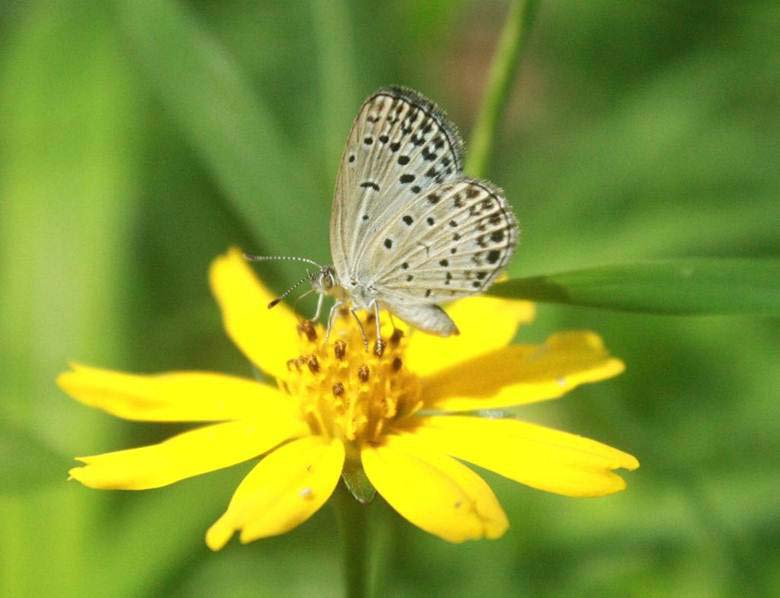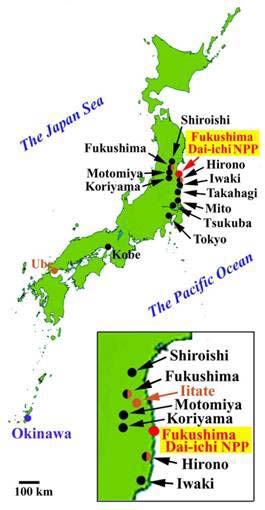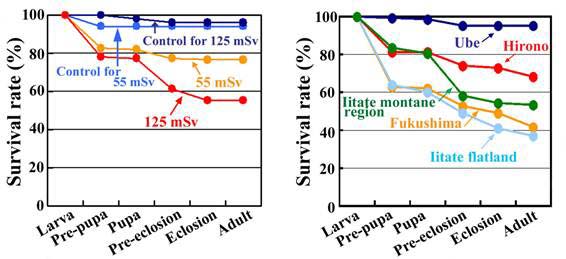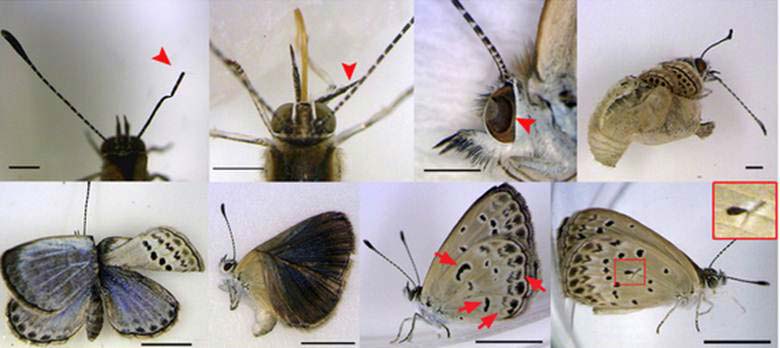The most thorough study combining field and lab research finds that the deformities caused by low-dose radiation persist and worsen over generations Dr. Mae-Wan Ho

Figure 1 The normal pale grass blue butterfly
Radiation from the Fukushima fallout caused physiological and genetic damage to the pale grass blue butterfly Zizeeria maha, concludes a research team at the University of the Ryukyus, Okinawa, Japan, whose results were published online in August 2013 [1].
Adult butterflies in the fallout area collected in May 2011 showed relatively mild abnormalities that became more severe and doubled in frequency in the next generation. These severe abnormalities were inherited, as shown by breeding from the deformed butterflies.
Adult butterflies collected from the same fallout area in September 2011 showed more severe abnormalities than those collected in May.
Similar abnormalities were experimentally reproduced by exposing larvae from a non-contaminated area to radiation externally or internally.
The health impacts of low-dose radiation have been strenuously denied and dismissed by governments and the pro-nuclear lobby and regulatory authorities even though there is overwhelming evidence from the Chernobyl fallout; and recent laboratory findings have documented numerous ‘bystander effects’ that amplify dose and harm from low level ionizing radiation (see I-SIS Report [2] Death Camp Fukushima Chernobyl for details).
The team led by Atsuki Hiyama and Chiyo Nohara decided to carry out their study on the pale grass blue butterfly (Figure 1) because butterflies are recognized indicators of environmental conditions and the species is widely distributed in Japan. Moreover, a reliable rearing method has been established in their laboratory.
The Fukushima meltdown and explosion occurred 12 March 2011 when the pale blue grass butterflies were overwintering as larvae. These larvae were exposed to radiation from the fallout not only externally but internally from feeding on contaminated leaves, and would have emerged as the first-voltine (first in the year) adult butterflies, which the team collected at various sites in the fallout area both north and south of Fukushima 13-18 May 2011. A total of 144 adults (111 males and 33 females) were collected from 10 localities (Figure 2, black and half black dots). Most appeared normal, but closer inspection revealed mild abnormalities such as reduced wing size in males, aberrant colour patterns, deformed wind shapes, and dented eyes. The overall frequency of abnormalities for 7 localities - excluding Shiroishi, Koriyama and Tokyo to allow comparison with the second field survey - was 12.4 %. The male forewing size was reduced, and the reduction was significantly negatively correlated with the ground radiation dose at the collection localities.

Figure 2 Butterfly collection sites (black and half black dots), and host plant leaves collection sites (brown and half brown dots)
The F1 offspring from the first-voltine females were produced and reared in the lab in Okinawa, located 1 750 km from Fukushima, where artificial radiation could scarcely be detected. In the F1 generation, the mortality rates of larvae, prepupae, and pupae, and abnormality rates in surviving adults were high for Iwaki, Hirono, Motomiya and Fukushima, and the overall abnormality rate was 18.3 %, 1.5 times the overall abnormality rate of the parent generation. The half-eclosion time (half the time it took for larvae to reach pupation stage) was negatively correlated with the distances of the collection localities from the Fukushima Dai-ichi NPP (nuclear power plant). Similarly, the half-pupation time and abnormality rate of appendages were negatively correlated, though not statistically significant. The abnormalities in the F1 butterflies were more severe, affecting legs, antennae, palpi, eyes, abdomen and wings.
To investigate whether the abnormalities in the F1 butterflies could be inherited, ten females with abnormalities (except one from Shiroishi, which did not have any detectable abnormality) were crossed with normal-looking F1 individuals from Tsukuba, the furthest from Fukushima Dai-ich NPP). Typically 3 virgin males and put into a cage with 1 virgin female to ensure successful mating. Although this mating system is nearly always successful, yielding more than 100 offspring per female when both males and females are normal and fertile, 3 out of the 10 F1 females produced less than 2 adult offspring.
Despite the fact that the females were crossed to normal looking males, and 3 out of ten of the females were almost completely infertile, the overall abnormality rate in the surviving F2 adults was 33.5 %; that, and the direct inheritance of several abnormality traits suggest that the deformities were inherited in dominant genetic (or epigenetic) fashion. In addition, a new abnormality of a forked antenna, never before observed, was found in a F2 individual. The increase in severity and frequency of abnormalities in adult butterflies in later generations is also found in the fallout areas. Some of the abnormal butterflies are shown in Figure 3.
Figure 3 Mutant butterflies from the Fukushima fallout
Six months after the accident in September and October 2011, the researchers again collected from the same sites; these were probably the fourth- or fifth-voltine butterflies. A total of 238 were collected, 168 females and 70 females. The overall abnormality rate for the 7 localities was 28.1 %, more than double that of the first-voltine adults collected in May. The total abnormality rate of the field collected adults in September 2011 was correlated with the ground radiation dose at the collected site.
As for the first-voltine butterflies, the F1 generation was produced from butterflies collected in September 2011, and reared in the lab. The mortality rate was high, and so was the abnormality rate, at 59.1 % overall. The results showed that the radiation-exposed populations in the wild had deteriorated substantially since May, “possibly due to genetic damage caused by radiation from the Fukushima Dai-ichi NPP,” as predicted from the breeding experiments with the first-voltine adults.The team exposed normal larvae and pupae obtained from females caught in Okinawa to radiation from Cesium-137, one of the major radioisotopes released in the Fukushima fallout. The larvae and pupae were exposed to 55 mSv (at a rate of 0.2 mSv/h) or 125 mSv (at a rate of 0.32 mSv/h). Both exposure levels results in abnormal traits. The survival curves showed that pre-pupal death rates (~15 %) were about the same for both doses, with the higher dose causing extra (20 %) deaths at the pupal stages (Firgure 4, left graph).
Leaves of host plants collected at different localities were fed to larvae from Okinawa. Almost all individuals that consumed leaves from the non-contaminated locality Ube (see Figure 2) survived, but individuals that consumed leaves from contaminated localities survived less well (Figure 4, right graph).
Figure 4 Survival rates on artificial exposures to radiation; left, external, right, internal
The abnormalities produced (Figure 5) are similar to those in those naturally exposed to radiation in the Fukushima fallout areas.
Figure 5 Representative abnormalities from internal exposures
The study by the University of the Ryukyus in Okinawa is the most thorough and comprehensive to-date on the impacts of low-dose ionizing radiation from nuclear accidents. The researchers have provided data from both natural butterfly collections and laboratory breeding experiments that show the natural populations of pale grass blue butterflies in the Fukushima area deteriorating physiologically and genetically from being exposed to radioactive fallout. In addition, they carried out experiments artificially exposing normal larvae to low-dose radiation, both externally and internally via the ingestion of contaminated host plant leaves; and reproduced the mortalities and abnormalities in the natural butterflies collected from the Fukushima area.
We fully agree with University of South Carolina biologist Tim Mousseau, who commented [3]: “This study is important and overwhelming in its implications for both the human and biological communities living in Fukushima.”
We repeat the call issued in our report [2]: “It is clear that children living in the highly contaminated areas outside the official evacuation zone around Fukushima Dai-ichi nuclear plants must be evacuated promptly in order to avert a humanitarian disaster on the scale of Chernobyl. Concerted international effort is needed to provide help for evacuating the children and to continue health monitoring and research on radioprotection. Finally, a global phase out of nuclear power is in order given that a combination of renewable energy options can provide all our energy needs safely, sustainably and at much more affordable costs for all, as we made the case thoroughly in [4] Green Energies - 100% Renewable by 2050, (ISIS Report).”Article first published 05/09/12
Got something to say about this page? Comment
There are 1 comments on this article so far. Add your comment above.
joe cummins Comment left 12th September 2012 14:02:29
The Fukushima butterflies provide the evidence that is needed to insure that the exposed population of people and animals that have been injured will be identified then treated as well as science can provide remedies for gene damage. More effective remedies may be found for the injured future generations and that is an area of research requiring immediate attention.